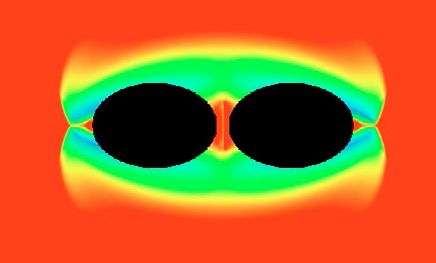March 14, 2013 report
Researchers find it would require 2.4 times less energy to create a black hole than thought

(Phys.org) —Frans Pretorius and William East of Princeton University have published a paper in Physical Review Letters, where they describe computer models they've developed that show that it would require 2.4 times less energy to create a black hole than previous research has suggested. They also note that despite this new finding, researchers are still very far away from being able to create a black hole, even the microscopic ones that aroused fears surrounding research at the Large Hadron Collider (LHC).
Black holes that exist out in space have captured the public's imagination as they are both distant and mysterious, and entail forces larger than most people can envision. Newer research, on the other hand, that has suggested that very tiny black holes can exist also and might even be created by smashing sub-atomic particles together in powerful colliders such as the LHC, have caused fear. In this new effort, the two researchers created models to help understand what happens when particles collide, what it might take to create a tiny black hole, and the likelihood of scientists ever being able to do so.
Researchers know that it is theoretically possible to create black holes because of Einstein's Theory of Relativity—particularly the part describing the relationship between energy and mass—increasing the speed of a particle causes its mass to increase as well. The computer model in this effort, which is based on Einstein's theories, provides a virtual window for viewing what happens when two particles collide—they focus their energies on each other and together create a combined mass that pushes gravity to its limit and as a result spawns a very tiny black hole. That result was expected—what was surprising was that the team found that their model showed that such a collision and result would require 2.4 times less energy than has been previously calculated to produce such a tiny black hole.
The team also notes that despite fears of researchers building a collider to replicate in real life what their model depicts—and in the process creating a black hole that would swallow the Earth—the science just isn't there yet. It would take billions of times more energy than even the LHC is able to generate and use. Also, even if they could create such a black hole, it would disappear just as quickly as it appeared, due to Hawking radiation.
More information: Ultrarelativistic Black Hole Formation, Phys. Rev. Lett. 110, 101101 (2013) DOI: 10.1103/PhysRevLett.110.101101
Abstract
We study the head-on collision of fluid particles well within the kinetic energy dominated regime (γ=8 to 12) by numerically solving the Einstein-hydrodynamic equations. We find that the threshold for black hole formation is lower (by a factor of a few) than simple hoop conjecture estimates, and, moreover, near this threshold two distinct apparent horizons first form postcollision and then merge. We argue that this can be understood in terms of a gravitational focusing effect. The gravitational radiation reaches luminosities of 0.014 c5/G, carrying 16±2% of the total energy.
Journal information: Physical Review Letters
© 2013 Phys.org




















